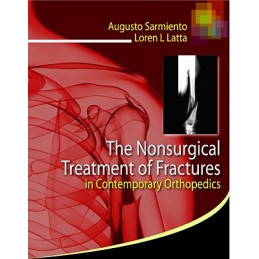- Reduced price

Order to parcel locker

easy pay


 Delivery policy
Delivery policy
Choose Paczkomat Inpost, Orlen Paczka, DHL, DPD or Poczta Polska. Click for more details
 Security policy
Security policy
Pay with a quick bank transfer, payment card or cash on delivery. Click for more details
 Return policy
Return policy
If you are a consumer, you can return the goods within 14 days. Click for more details
A thorough review of the nonsurgical treatment of fracture repair
Nonsurgical Treatment of Fractures in Contemporary Orthopedics deals with nonsurgical treatment of fractures of the tibial diaphysis, the humeral shaft, the isolated fracture of theulna, and the Colles fracture.The book is highlighted by numerous full-color and black and white photographs and drawings and provides a thorough grounding in the basic science of fracture healing and biomechanics.
Features
Data sheet
Section I:: Introduction
Chapter 1 Pertinent Basic Science of Fracture Healing and Biomechanics
Section II:: The Tibial Fractures
Chapter 2 The Closed Tibial Fracture:: Introduction
Chapter 3 Overall Management Protocol
Chapter 4 Acute Care:: Compartment Syndrome
Chapter 5 The Initial Above-the-Knee Cast
Chapter 6 The Below-the-Knee Functional Cast
Chapter 7 The Pre-fabricated Functional Brace
Chapter 8 The Custom-made Brace
Chapter 9 The Role of the Fibula
Chapter 10 Overall Clinical Experiences
Chapter 11 Fractures in the Proximal-third and Representative Examples
Chapter 12 Fractures in the Middle-third, Clinical Results and Representative Examples
Chapter 13 Fractures in the Distal-third, Clinical Results and Representative Examples
Chapter 14 The Segmental Fracture, Results and Representative Examples
Chapter 15 The Open Fractures
Chapter 16 Pathological Fractures
Chapter 17 Delayed Unions and Nonunions
Chapter 18 Tibial Condylar Fractures and Intra-articular Extensions
Chapter 19 Notes on other Treatment Modalities
Chapter 20 Plate Fixation
Chapter 21 Interlocking Intramedullary Nailing
Section III:: The Femoral Shaft Fractures
Chapter 22 Rationale, Technique and Representative Examples
Section IV:: The Humeral Shaft Fractures
Chapter 23 Rationale of Functional Bracing
Chapter 24 Indications and Contraindications
Chapter 25 Initial Management
Chapter 26 The Application of the Functional Brace
Chapter 27 Post-bracing Management
Chapter 28 Cautions and Pitfalls
Chapter 29 Shoulder Subluxation
Chapter 30 Associated Nerve Palsy
Chapter 31 Obesity
Chapter 32 Malrotation
Chapter 33 Angular Deformities
Chapter 34 Skin Problems
Chapter 35 The Polytraumatized Patient
Chapter 36 The Open Fracture
Chapter 37 The Proximal-third Fractures and Representative Examples
Chapter 38 The Middle-third Fractures and Representative Examples
Chapter 39 The Distal-third Fractures and Representative Examples
Chapter 40 The Segmental Fracture and Representative Examples
Chapter 41 Bilateral Shaft Fractures
Chapter 42 Delayed Unions and Nonunions
Chapter 43 Clinical and Radiological Results
Chapter 44 Other Treatment Modalities:: The Role of Plating
Section V:: The Isolated Ulnar Fracture
Chapter 45 Rationale of Functional Treatment
Chapter 46 Indications and Contraindications
Chapter 47 Acute Management:: Closed Fractures
Chapter 48 Open Fractures
Chapter 49 The Prefabricated Brace:: Instructions and Expectations
Section VI:: The Colles Fracture
Chapter 50 Rationale of Functional Treatment
Chapter 51 Classification of Colles Fracture
Chapter 52 The Etiology of Recurrent Deformity
Chapter 53 The Distal Radio-ulnar Joint
Chapter 54 The Long-oblique Fracture
Chapter 55 Late Arthritic Changes
Chapter 56 Immobilization:: Pronation versus Supination
Section VII:: Fractures of Both Bones of the Forearm
Chapter 57 Rationale and Indications
Chapter 58 Technique and Representative Examples
Section VIII:: Isolated Radial Shaft Fractures
Chapter 59 Rationale, Indications, Technique and Representative Examples
Index
